The majestic appearance and gentle nature of sea turtles make them a favorite of divers and swimmers worldwide. These impressive animals effortlessly glide through ocean waters. Although they are cold-blooded reptiles and require oxygen, sea turtles live nearly their entire lives in the ocean. In fact, there are documented cases of sea turtles living to over 100 years old!

From the smallest sea turtle, which is just larger than a dinner plate, to the largest, which can grow over 8 feet long, sea turtles continue to charm and fascinate us. Learn more about these captivating creatures with 10 incredible sea turtle facts!
1. Sea Turtles Have Been Around Longer Than Dinosaurs
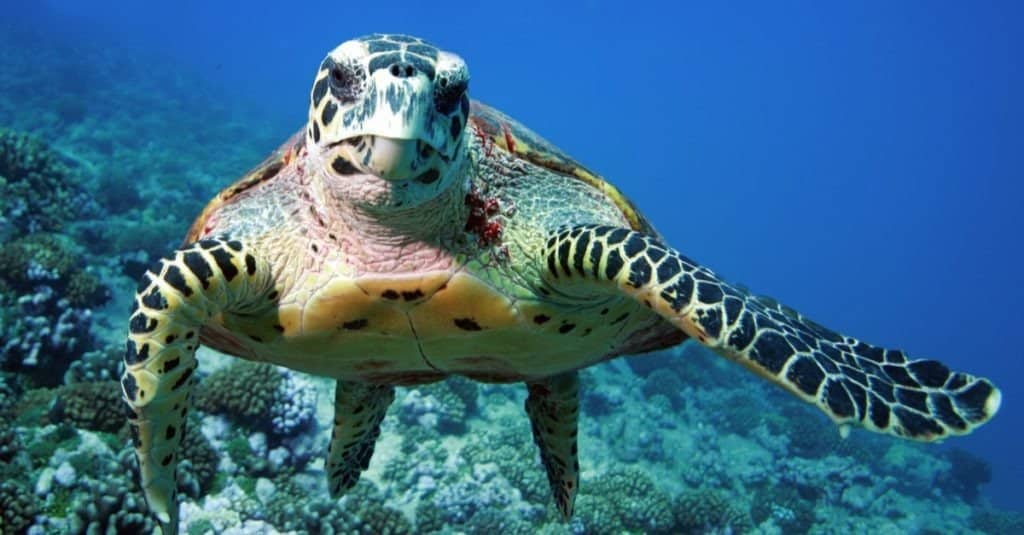
Scientists thought leatherback sea turtles were descendants of the Archelon, an ancient marine turtle.
©Achimdiver/Shutterstock.com
The first incredible sea turtle fact is that the earliest sea turtles lived over 100 million years ago and even survived the dinosaur extinction. The oldest known fossil is Desmatochelys padillai, a six-foot-long sea turtle that shared many characteristics with modern sea turtles today. For example, padillai had paddle-like limbs, as well as a carapace or top shell.
Today, there are seven species of sea turtles that live on Earth. They can be found in all the Earth’s oceans, except for the coldest regions. These ancient mariners are well-adapted to living on the go, often traveling great distances for food, mating, and laying eggs. The rarest species of sea turtle, the Kemp’s ridley sea turtle, is also the smallest, growing between 23-28 inches in length. The leatherback sea turtle is the largest and can grow 6-7 feet long and weigh 600-1,500 pounds.
2. Sea Turtle Shells Have Over 50 Bones
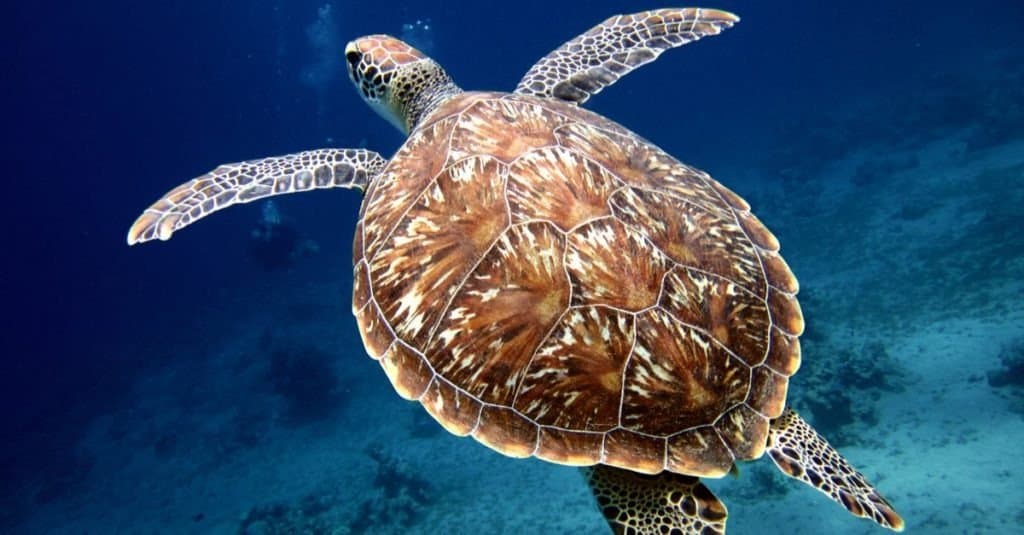
These marine reptiles have both internal and external skeletons.
©Kjeld Friis/Shutterstock.com
Sea turtles have both internal and external skeletons. The external skeleton, which includes the shell, protects and supports the internal organs. It comprises over 50 bones fused to the spine (except in leatherback turtles). The internal skeleton, on the other hand, acts as an anchor for the muscles.
Because of this construction, sea turtles cannot pull their heads and legs into their shells. Instead, they are streamlined with their flipper-shaped legs extended on the outside. Their front legs function like paddles and propel them through the water.
3. The Life History of a Sea Turtle Is Written in Its Bones
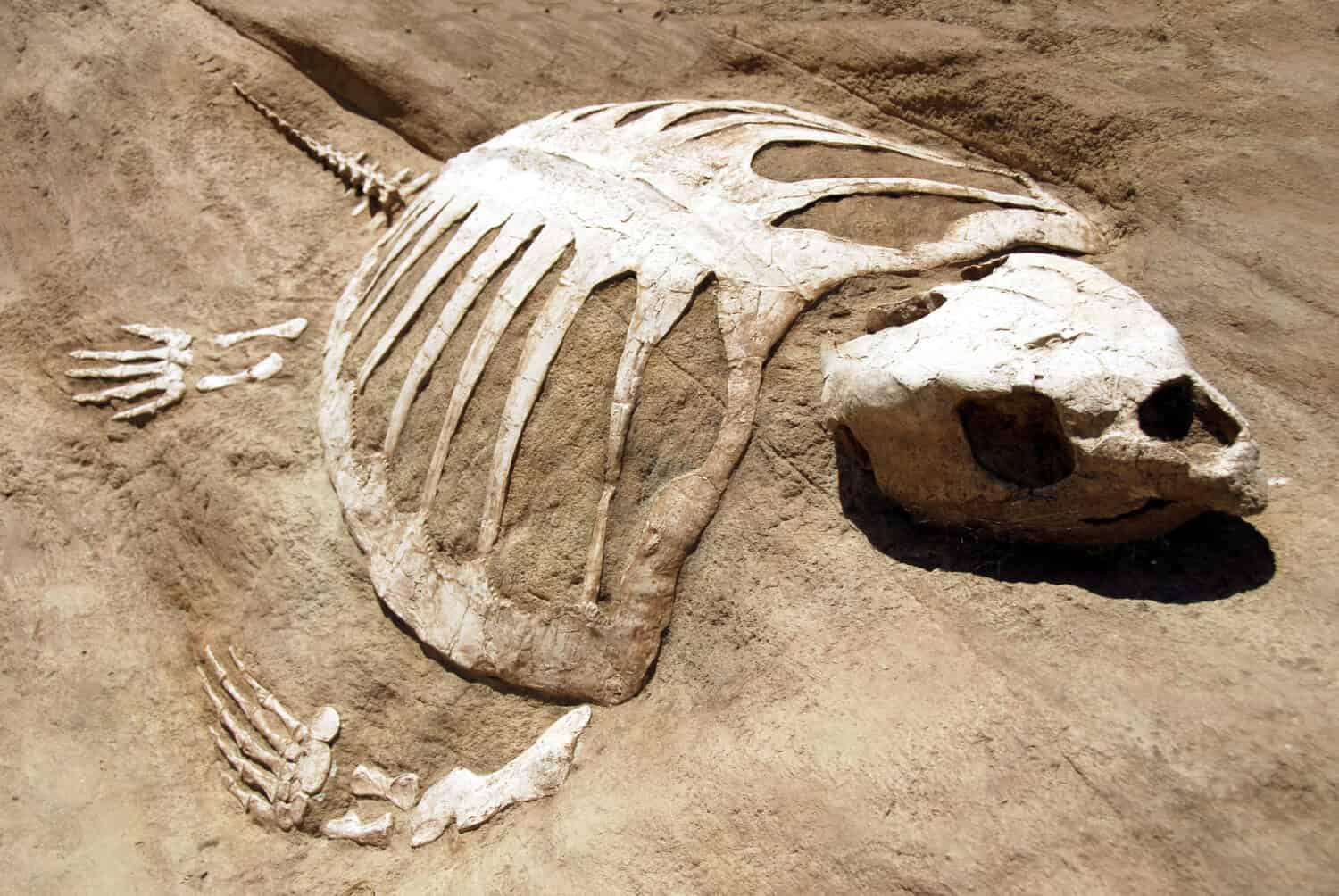
Scientists can learn a lot from sea turtles’ bones.
©Mike Brake/Shutterstock.com
The bones of sea turtles can tell their life histories! There are “annual rings” inside the humerus bones of their flippers, similar to those found in tree trunks. These annual rings contain chemical markers that can reflect what the turtle was eating, its age, and its habitat during each year of its life. Today, many researchers who study sea turtles can finally get a glimpse into their early years by studying their bones.
4. Sea Turtles Do Not Have Any Teeth
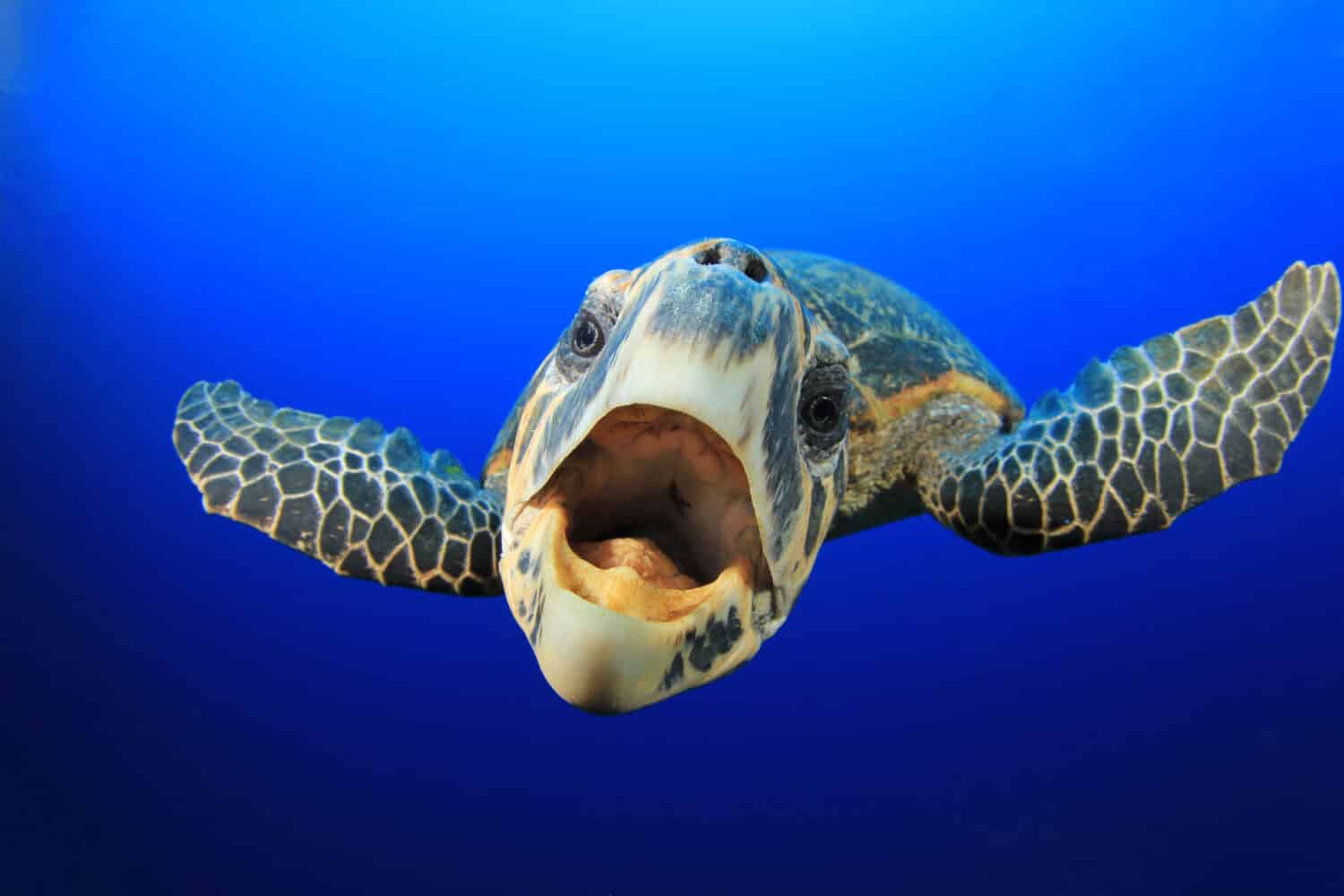
Their beaks are sharp, but sea turtles don’t have teeth.
©Rich Carey/Shutterstock.com
Sea turtles have beak-like mouths that they use to grasp and tear food floating through the ocean water. They do not have any teeth, but their beaks are sharp and made of keratin (the same material that makes up our fingernails). There are also backward-facing spines inside their mouths that help prevent slippery prey like jellyfish from escaping back into the water.
Most sea turtles eat jellyfish, but each species hunts different prey. For example, leatherback turtles mostly eat jellyfish and other soft-bodied animals, while loggerhead turtles eat shelled animals like clams and crabs. Kemp’s ridley turtles also prefer crabs, while green sea turtles eat seagrass. For hawksbill turtles, sea sponges and other invertebrates are their preferred prey.
5. Sea Turtles Can Travel Incredibly Long Distances
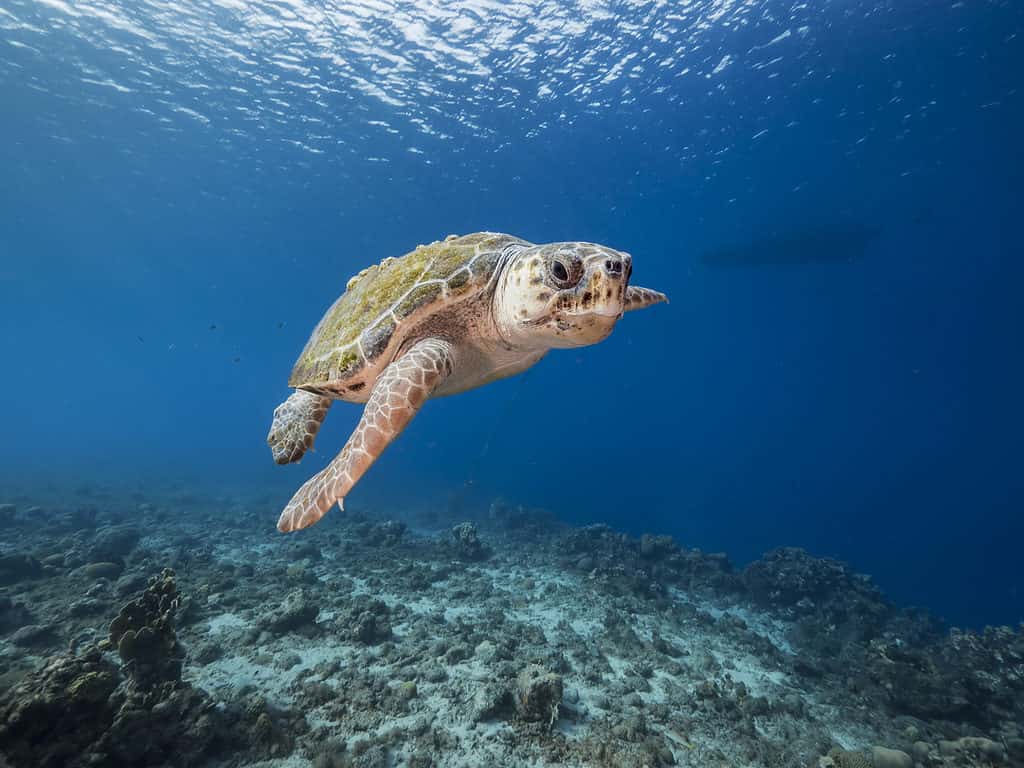
Some sea turtles migrate over 1,500 miles between feeding and nesting grounds.
©iStock.com/naturepics_li
Hawkbill sea turtles generally stay within a smaller base area for most of their lives. However, species like green sea turtles and olive ridley sea turtles migrate over 1,500 miles between feeding areas and nesting grounds. Moreover, loggerhead and leatherback sea turtles often travel several thousand miles each year.
The longest recorded journey of a single sea turtle is held by a female leatherback who swam nearly 13,000 miles from Indonesia to the west coast of the United States. Her journey was tracked for 647 days, which means she had to swim over 20 miles each day!
6. Sea Turtles Have Their Own Built-in Navigation Systems
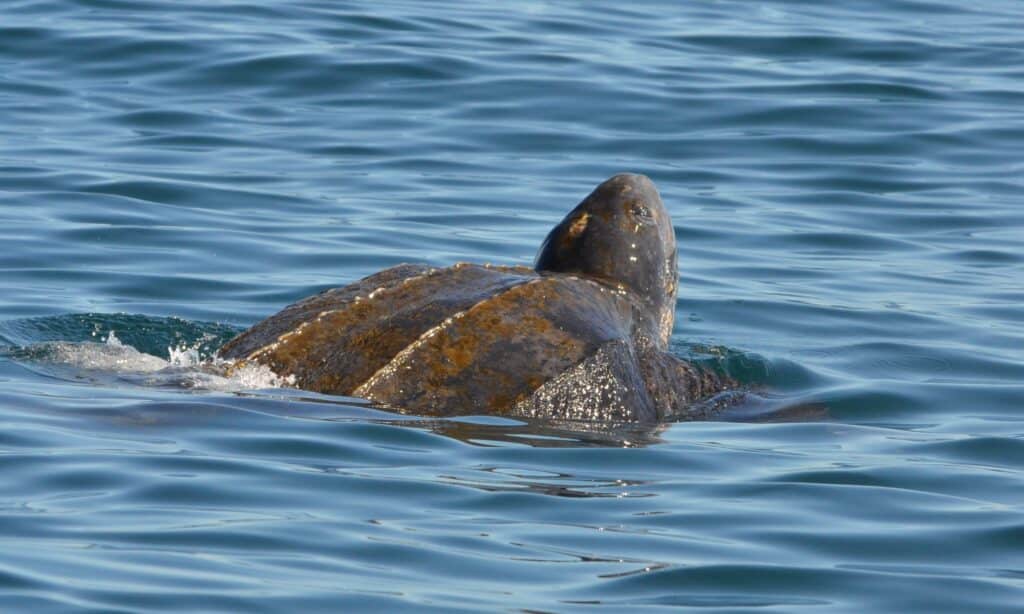
Leatherback sea turtles are the only sea turtles that have leather-like backs instead of hard bony shells.
©iStock.com/jtstewartphoto
Sea turtles travel long distances as they migrate to feeding grounds and then back to specific nesting areas. They are extremely sensitive to the earth’s magnetic fields, and they use these to navigate across the wide expanse of ocean water. Sea turtles have magnetite particles in their brains, which likely help them to orient to the earth’s magnetic poles like a compass.
After mating, for example, a female sea turtle will return to the same beach where she hatched to lay her eggs. But how does she know which beach to return to? And how does she find it in the large expanse of the wide-open ocean? She uses her built-in GPS navigation!
Baby sea turtles imprint on the specific magnetic signature of the beach where they hatch. Decades later, when they are sexually mature, female sea turtles use this magnetic map to guide them back to the same beach to lay their eggs!
7. Some Sea Turtles Make Belching Sounds
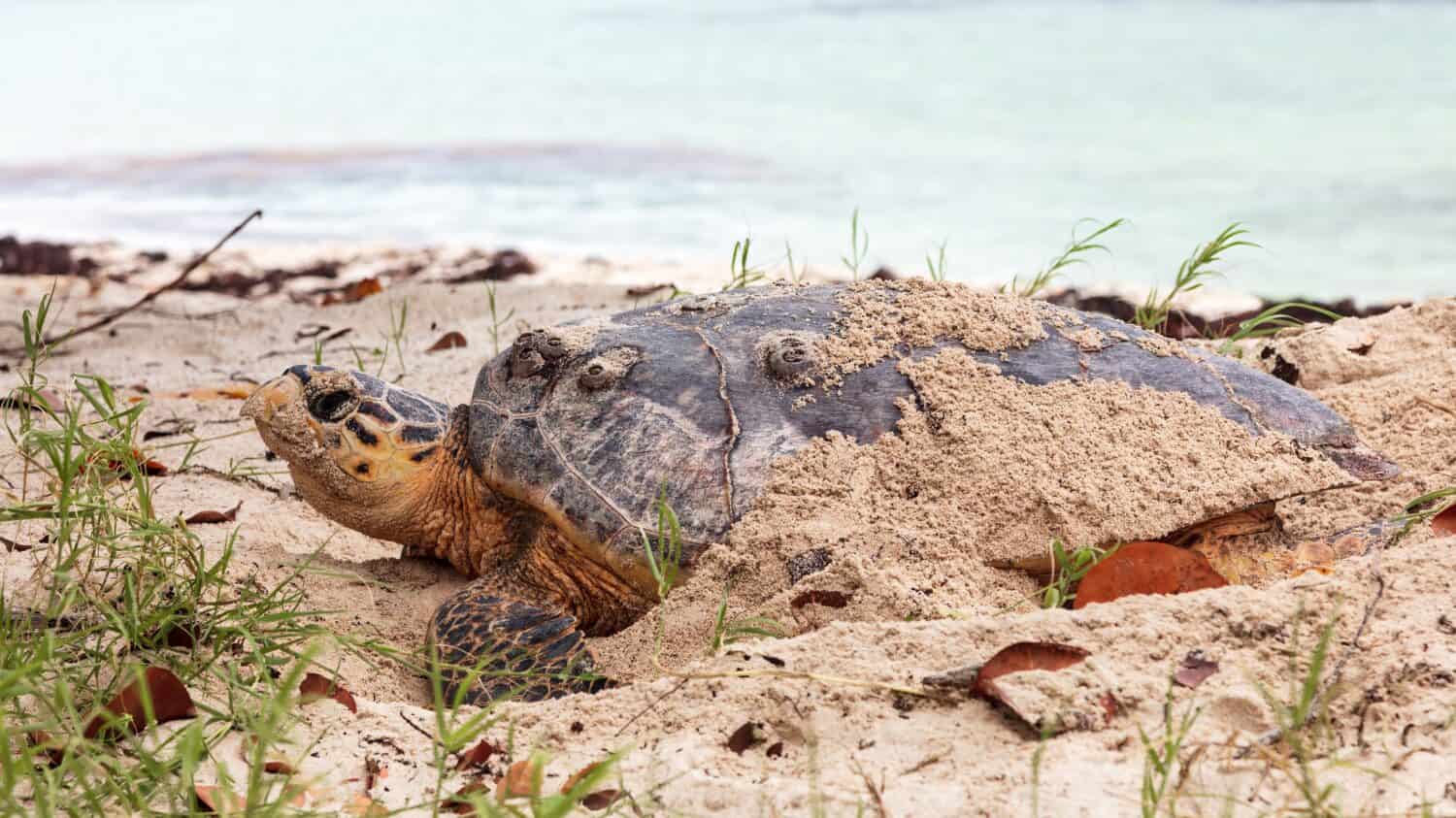
Female sea turtles make strange noises as they lay eggs.
©Otto Borik/Shutterstock.com
Sea turtles reach sexual maturity between 20-30 years of age. Although they mate in the sea, female sea turtles return to the beach where they hatched to lay their eggs.
The female sea turtle digs a nest in the sand using her back flippers, where she deposits around 150 soft-shelled eggs and covers them with sand. While nesting in the sand, a female leatherback turtle produces strange noises that sound a lot like human belching.
8. Only A Few Baby Sea Turtles Survive

Baby sea turtles race to the water to begin their lives in the ocean.
©zulkamalober/Shutterstock.com
After the female sea turtle has deposited and buried her eggs in the sand, she returns to the ocean. This means that once the baby sea turtles hatch, they are on their own. After hatching, baby sea turtles must dig their way out of the sandy nest and drag their small bodies to the sea.
However, just getting from the nest to the ocean is an extremely dangerous journey. A sad sea turtle fact is that many hatchlings are picked off by sea birds and other predators before they ever reach the water.
The baby turtles that make it to the ocean still face many more dangers like storms, pollution, plastics, and predators. Sadly, less than 0.1% of all hatchlings will survive the first two decades of life. In other words, only 1 out of 1,000 sea turtle hatchlings will live long enough to mature to adulthood.
9. Sea Turtles Can Hold Their Breath for Up to Seven Hours at a Time
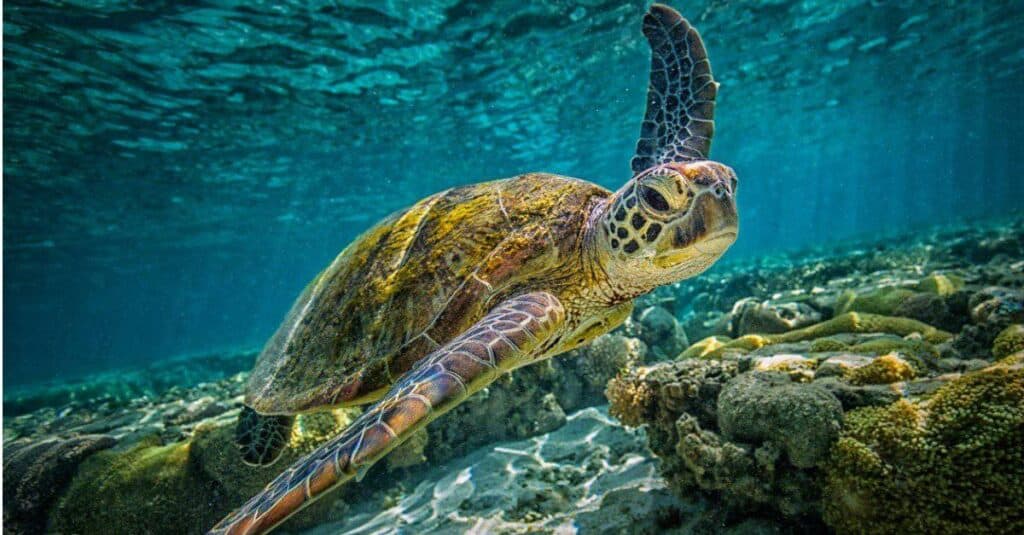
Turtles use cloacal respiration in addition to respiration with their lungs.
©iStock.com/Greg Sullavan
Sea turtles can dive almost 1,000 feet into the ocean as they hunt for food. Leatherback sea turtles, however, can travel much further, reaching depths of over 3,000 feet! Leatherback sea turtles also have collapsible lungs, flexible shells, and oxygen storage in their muscles and blood. This allows them to compress their bodies and safely handle the change in pressure as they travel deeper into the sea.
10. All Seven Sea Turtle Species Are in Danger of Extinction

All sea turtles are in danger of extinction.
©Aaronejbull87/Shutterstock.com
Although they were once abundant throughout the earth’s oceans, all seven sea turtle species are now in danger of becoming extinct due to human-related activities. This includes habitat loss, climate change, illegal collection and trade, commercial fishing, and marine plastics and pollutants.
Sea turtles cannot breathe underwater, so they periodically return to the surface for air. When they are actively hunting, sea turtles need to return to the surface more frequently. However, when they are resting, sea turtles can hold their breath for four to seven hours at a time! During this time, their heart rate slows to conserve oxygen, and may only beat once every nine minutes.
Sea turtles are often victims of “bycatch” when they are accidentally caught up in commercial fishing nets and unable to return to the surface for oxygen. Many people also illegally harvest sea turtle eggs and traffic sea turtle products.
The sex of a sea turtle is determined by the egg’s temperature during incubation. Warmer temperatures produce more female turtles, while cooler temperatures produce more males. Due to climate change, the beaches and sand where eggs are laid are becoming warmer. This means that most sea turtle hatchlings are female, which dramatically skews the sex ratios in sea turtle populations.
Although sea turtles are facing a critical point in history, there are many policies today that protect their habitats and prohibit killing them or collecting their eggs. Many organizations are helping to reduce bycatch as well by implementing fishing tools that are sea turtle friendly. If we can continue these interventions, there is a much greater chance that we can help sea turtles from going extinct.
The photo featured at the top of this post is © iStock.com/PERICE
Thank you for reading! Have some feedback for us? Contact the AZ Animals editorial team.






